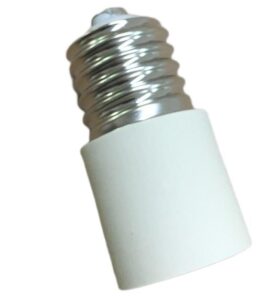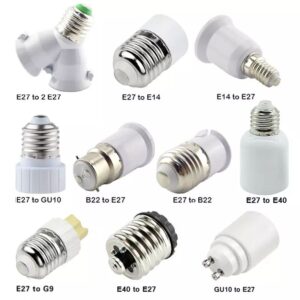Using the wrong voltage bulb can cause safety issues or make your lighting inefficient. Fortunately, using a 110V bulb in a 120V socket is usually safe because of the close voltage range. However, it may affect the performance of the bulb.
Yes, you can use a 110V light bulb in a 120V light socket. The difference in voltage is so small that the light bulb will still work safely and effectively. It might have a slightly reduced life and be a little dimmer.
Let’s go more in-depth on light bulbs and sockets compatibility below.
Can You Put Any Light Bulb in a Socket?
No, not every light bulb can be safely placed in any lamp holders. Each socket and bulb type has a specific rating for voltage, wattage, and bulb size.
For example, using a bulb with higher wattage than the socket is rated for can cause overheating and potential fire hazards. Also, the base size of the bulb has to match the socket for it to screw in properly. Some light sockets are designed for specific types of bulbs, such as E26 for standard household use and GU10 for spotlights.

What Happens If You Use the Wrong Voltage Light Bulb?
Using a light bulb with incorrect voltage can lead to inefficient lighting or even damage. If you use a bulb with a voltage lower than the socket, it may not light up properly, or it might burn out quickly. Conversely, using a higher voltage bulb in a low-voltage socket could cause overheating, sparking, or even the bulb bursting, presenting significant safety hazards. It’s important to always check voltage compatibility before installation.
Can I Use a 110V Bulb in a 120V Socket?
Yes, you can. The small voltage difference between 110V and 120V is generally insignificant in everyday use. The bulb may run slightly dimmer and have a shorter lifespan, but it will work safely without any major risks. Most modern bulbs and sockets are designed to handle minor variations in voltage.
Are Most Light Bulbs 120V?
Yes, most light bulbs designed for use in North America are rated for 120V. This is the standard voltage in U.S. households and commercial buildings. However, bulbs in other regions, such as Europe, are commonly rated for 220V to 240V. It’s crucial to check both the bulb and socket specifications to ensure compatibility.
What Does the “V” Stand for on a Light Bulb?
The “V” on a light bulb stands for voltage, which is a measure of the electrical potential difference. Voltage is important because it determines how much electricity flows through the bulb. Using a bulb with a voltage rating that does not match the socket can result in poor performance or even damage to the bulb or socket.

Do LED Lights Run on 120V?
Yes, many LED lights are designed to run on 120V. In fact, most LED bulbs available for household use in North America are compatible with the 120V standard. LED technology is versatile, and LED bulbs are often built to handle a range of voltages, including both 120V and 240V systems.
What Is the Safe Voltage for LED Lights?
LED lights are typically safe to use with standard household voltages, which is 120V in North America. However, low-voltage LED systems, such as 12V or 24V, are commonly used for outdoor lighting or specialized indoor applications. Always ensure the correct transformer is used if operating low-voltage LED bulbs.
Can I Use a 220V Bulb in a 120V Lamp?
No, a 220V bulb should not be used in a 120V socket. If you install a 220V bulb in a 120V socket, the bulb will not function properly. It may flicker, fail to light up fully, or burn out quickly. In worst-case scenarios, it could cause electrical damage to the socket or circuit.
Is 110V and 120V the Same?
In practical terms, 110V and 120V are treated as the same for most electrical applications in North America. Although technically different, the variations in voltage are minimal, and appliances or light bulbs rated for 110V can usually function in 120V sockets without issue.

What Happens If I Use the Wrong Light Bulb?
Using the wrong light bulb, whether in terms of voltage or wattage, can result in several issues. A bulb with higher wattage than the socket can handle may overheat, potentially causing fire hazards. A bulb with incorrect voltage may burn out quickly or provide insufficient light. Always match the bulb to the socket’s specifications to avoid such problems.
What Is the Difference Between 110V and 120V?
The difference between 110V and 120V is minimal, with only a 10V variance. This slight difference is not significant enough to affect the functionality of most household appliances and bulbs. Most light bulbs designed for one will work in the other without noticeable issues.
What Can You Plug into a 120V Outlet?
A 120V outlet is the standard for most household electrical appliances in North America. You can plug in a wide range of devices, from light bulbs to small kitchen appliances, provided they are designed for 120V. Always check the voltage rating of any device before plugging it in.

Can I Plug a 110V into a 125V Outlet?
Yes, you can safely plug a 110V device into a 125V outlet. The voltage range is close enough that it won’t pose any safety risks. Many modern devices, including light bulbs and appliances, are designed to handle a range of voltages from 110V to 125V.
What Is the Difference Between a 120V and a 130V Light Bulb?
A 130V light bulb is designed for slightly higher voltage and may last longer when used in a 120V socket. However, the tradeoff is that it will run dimmer compared to a bulb rated exactly for 120V. This higher voltage rating makes 130V bulbs ideal for commercial or industrial environments where power surges are more common.
In most cases, using a 110V bulb in a 120V lamp socket is safe and won’t cause significant issues.













